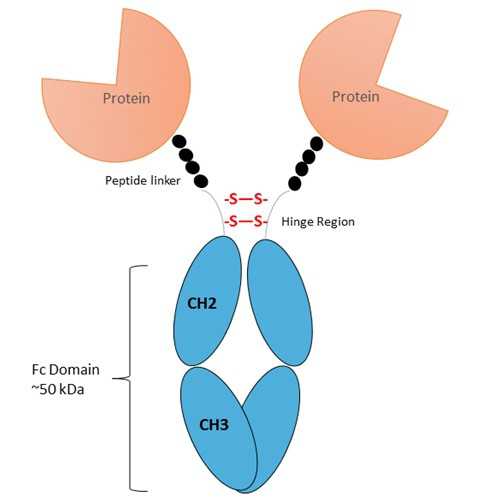Recombinant mouse TIM-3 Fc-Fusion Protein
Recombinant human TIM-3 Fc-Fusion Protein expressed in HEK293 cells.
Highlights:
- Prolongs of the plasma half-life (t1/2) of the protein of interest in vivo, resulting in improved therapeutic efficacy
- In vitro applications of Fc-Fusion proteins include immunohistochemistry (IHC), flow cytometry (FC), protein binding assays, and use as microarray baits
- Fc domain-Fusion can also improve the in vivo and in vitro solubility and stability of some binding partners
Hepatitis A virus cellular receptor 2 (TIM-3) is a surface receptor implicated in modulating innate and adaptive immune responses. It is generally accepted to have an inhibiting function, and reports on stimulating functions suggest that the activity may be influenced by the cellular context and/or the respective ligand.
From our sister company Absolute Antibody.
Recombinant human TIM-3 Fc-Fusion Protein expressed in HEK293 cells.
Highlights:
- Prolongs of the plasma half-life (t1/2) of the protein of interest in vivo, resulting in improved therapeutic efficacy
- In vitro applications of Fc-Fusion proteins include immunohistochemistry (IHC), flow cytometry (FC), protein binding assays, and use as microarray baits
- Fc domain-Fusion can also improve the in vivo and in vitro solubility and stability of some binding partners
Hepatitis A virus cellular receptor 2 (TIM-3) is a surface receptor implicated in modulating innate and adaptive immune responses. It is generally accepted to have an inhibiting function, and reports on stimulating functions suggest that the activity may be influenced by the cellular context and/or the respective ligand.
From our sister company Absolute Antibody.
For larger sizes, please Contact Us for a bulk discount.
Specifications
| Product Type: | Protein |
| Alternative Name(s): | Hepatitis A virus cellular receptor 2, HAVcr-2, T-cell immunoglobulin and mucin domain-containing protein 3, TIMD-3, T-cell immunoglobulin mucin receptor 3, TIM-3, T-cell membrane protein 3 |
| Accession ID: | Q8TDQ0 |
| Antigen: | TIM-3 |
| Host: | HEK293 |
| Fc domain: | mouse IgG1 |
| Species: | mouse |
| Extinction Coefficient: | 119900 |
| Molecular Weight: | 91703.98 Da |
| Amino Acid Sequence: | SLENAYVFEVGKNAYLPCSYTLSTPGALVPMCWGKGFCPWSQCTNELLRTDERNVTYQKSSRYQLKGDLNKGDVSLIIKNVTLDDHGTYCCRIQFPGLMNDKKLELKLDIKAAKVTPAQTAHGDSTTASPRTLTTERNGSETQTLVTLHNNNGTKISTWADEIKDSGETIRTAGGGGSVPRDQGCKPCICTVPEVSSVFIFPPKPKDVLTITLTPKVTCVVVDISKDDPEVQFSWFVDDVEVHTAQTKPREEQINSTFRSVSELPIMHQDWLNGKEFKCRVNSAAFPAPIEKTISKTKGRPKAPQVYTIPPPKEQMAKDKVSLTCMITNFFPEDITVEWQWNGQPAENYKNTQPIMDTDGSYFVYSKLNVQKSNWEAGNTFTCSVLHEGLHNHHTEKSLSHSPGKHHHHHH |
| Purity: | >95% (SDS-PAGE) |
| Buffer: | PBS + 0.02% Proclin 300 |
| Amount: | 0.1mg |
| Activity: | Cell surface receptor implicated in modulating innate and adaptive immune responses. Generally accepted to have an inhibiting function. Reports on stimulating functions suggest that the activity may be influenced by the cellular context and/or the respective ligand (PubMed:24825777). Regulates macrophage activation (PubMed:11823861). Inhibits T-helper type 1 lymphocyte (Th1)-mediated auto- and alloimmune responses and promotes immunological tolerance (PubMed:14556005). In CD8+ cells attenuates TCR-induced signaling, specifically by blocking NF-kappaB and NFAT promoter activities resulting in the loss of IL-2 secretion. The function may implicate its association with LCK proposed to impair phosphorylation of TCR subunits, and/or LGALS9-dependent recruitment of PTPRC to the immunological synapse (PubMed:24337741, PubMed:26492563). In contrast, shown to activate TCR-induced signaling in T-cells probably implicating ZAP70, LCP2, LCK and FYN (By similarity). Expressed on Treg cells can inhibit Th17 cell responses (PubMed:24838857). Receptor for LGALS9 (PubMed:16286920, PubMed:24337741). Binding to LGALS9 is believed to result in suppression of T-cell responses, the resulting apoptosis of antigen-specific cells may implicate HAVCR2 phosphorylation and disruption of its association with BAG6. Binding to LGALS9 is proposed to be involved in innate immune response to intracellular pathogens. Expressed on Th1 cells interacts with LGALS9 expressed on Mycobacterium tuberculosis-infected macrophages to stimulate antibactericidal activity including IL-1 beta secretion and to restrict intracellular bacterial growth (By similarity). However, the function as receptor for LGALS9 has been challenged (PubMed:23555261). Also reported to enhance CD8+ T-cell responses to an acute infection such as by Listeria monocytogenes (By similarity). Receptor for phosphatidylserine (PtSer), PtSer-binding is calcium-dependent. May recognize PtSer on apoptotic cells leading to their phagocytosis. Mediates the engulfment of apoptotic cells by dendritic cells. Expressed on T-cells, promotes conjugation but not engulfment of apoptotic cells. Expressed on dendritic cells (DCs) positively regulates innate immune response and in synergy with Toll-like receptors promotes secretion of TNF-alpha. In tumor-imfiltrating DCs suppresses nucleic acid-mediated innate immune repsonse by interaction with HMGB1 and interfering with nucleic acid-sensing and trafficking of nucleid acids to endosomes (By similarity). Expressed on natural killer (NK) cells acts as a coreceptor to enhance IFN-gamma production in response to LGALS9 (PubMed:22323453). In contrast, shown to suppress NK cell-mediated cytotoxicity (PubMed:22383801). Negatively regulates NK cell function in LPS-induced endotoxic shock (By similarity) [Uniprot]. |
| Mycoplasma Tested: | <1.0 EU/mg |
| Storage: | Store at 4C up to 1 month. Small volumes at -20C for longer storage. |
| Shipped: | Cold packs |
Documentation
References
If you publish research with this product, please let us know so we can cite your paper.


